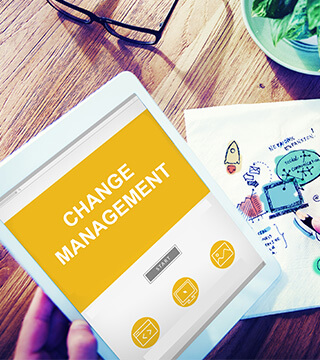 If you assign an employee a new portfolio, do they have to spend the first week figuring out how the record management and data collection systems work, or are they able to get right to the most important tasks? What is the correct approach to environmental management business management?
If you assign an employee a new portfolio, do they have to spend the first week figuring out how the record management and data collection systems work, or are they able to get right to the most important tasks? What is the correct approach to environmental management business management?
This article goes deep into how applying principles of management of change (MOC) can be applied to the business side of environmental management to increase efficiency in the face of challenges like employee turnover and regulatory changes.
Managing a department of EH&S professionals is all about change management. Regulatory changes, employee changes, and material changes all affect your ability to work effectively. It’s the job of compliance professionals to be the steady and knowledgeable leaders guiding the way through corporate turnovers and regulatory changes. Change management is a part of everything an executive is responsible for overseeing.
Talk to almost any EH&S manager and they’ll tell you that they have been working for the industry for many years, but often not in the same position for too long. There’s a lot of movement from position to position or facility to facility among environmental professionals. And if you ask the C-Suite what the biggest challenge is in EHS and they'll tell you it's the business side of things: environmental management business management.
It seems like just as an employee mastered one portfolio or gotten on top of a facility’s permit requirements they’re reassigned to take charge of a whole new portfolio. How can you ensure they’re able to tackle these challenges head on without stumbling?
One day an employee could be in charge of permitting for the facilities in one state, and the next they could be responsible for all air permits across the U.S. Or you might have to change their portfolio from air emissions management to systems analysis/improvement. Each new task is as important and challenging as the next.
Environmental management business management, and management of change (MOC) present some specific challenges for the EHS professional:
- Staff always have to hit the ground running and you may never really feel like they’ve mastered their current portfolio before they are moved somewhere else.
- Each new environmental portfolio assignment requires catching up on the unfinished tasks the previous employee didn’t complete (usually because they too had to play catch up themselves, since their predecessor was likely whisked away to another position).
- It’s difficult to improve or update systems when your team isn’t in one place long enough to fully analyze your systems and see projects through over the long term.
- Each portfolio might use a completely different data management system, meaning your employee needs to learn a “whole new language” and decipher new databases every time they pick up new responsibilities.
Combined, these challenges amount to something far more volatile than mere personal frustration for EH&S executives and staff – it also leads to increased risk for regulatory noncompliance, missing deadlines, losing vital data, and being perpetually stuck playing catch up with your regulatory obligations on a corporate-wide level. In essence, how you manage change and ensure business continuity in your EH&S department has an enormous impact on how well you perform in environmental, health, and safety compliance.
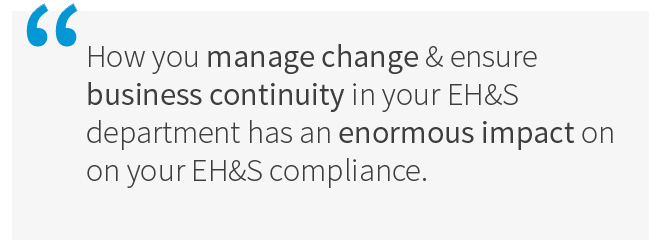
Pinpointing Opportunities for Change Management Success
So what can you do about the problem of business continuity and change management from an EH&S perspective?
Consider this: the systems you use for your environmental management may be the key to your success.
The environmental management system your employees use to manage all their EH&S responsibilities from portfolio to portfolio is actually your secret weapon for ensuring business continuity and mitigating. Note, too, that it’s system and not systems – the key is to implement one centralized, standardized environmental database.
And here’s why: when it comes to environmental management tools, two heads are not necessarily better than one. Having to learn the ins and outs of dozens of separate databases, spreadsheets, or environmental management systems (EMSs) steals away weeks of potentially productive time at the beginning of a newly assigned portfolio.
Ask yourself: is it immediately clear where all the important data your staff uses is coming from, or do they have to decipher a complex series of spreadsheet formulas to find out how their predecessor was coming up with their numbers?
Most environmental managers are immensely relieved (and a little surprised) when they don’t have to start from zero and learn things from scratch with every new portfolio when there’s a standardized system in place. Most importantly, this relief translates to more productivity, fewer errors and less risk – in other words, business continuity you can count on.
How a Standardized EMS Improves Business Continuity
While there are many benefits to having a standardized and centralized EMS, one that often goes overlooked is the benefit of having all the tools and data employees need to do their job, the instant they need them, regardless of where they are or what tasks they’re undertaking.
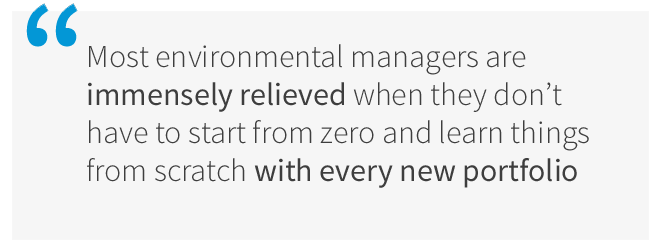
If you’ve just assigned a new portfolio to a new hire, or promoted an EH&S manager to be responsible for the regulatory compliance of a totally different area of operations, it’s important that they know exactly where to find all the data and records their predecessor was using to do their job. And it’s even more important to be confident that they’ve been recording and processing data in the same manner as in previous posts since your team uses the same corporate-wide standards for environmental data management.
Implementing a central EMS for your entire organization gives you three benefits that overcome the challenges of business continuity:
- The structure of the EMS enforces those corporate-wide data management standards. Data is stored and collected in a way that compliments your goals and compliance needs. Data can always be found exactly where it should be and there’s no room for someone to misinterpret how records should be kept.
- Every EH&S professional is kept on the same page, meaning that moving from portfolio to portfolio will not require your team to relearn everything from page one. They’ll already know where to find the data they need and can hit the ground running.
- Executive management can oversee the progress of their entire EH&S department from the centralized database so that you always know where your business’ compliance and environmental performance stands. Even in times of extreme employee turnaround or massive changes in the EH&S team, the upper-level managers can keep tabs on and ensure things are running smoothly.
In short, those benefits of standardization and centralization help ensure your business is running normally during times of change and uncertainty. They aren’t just about environmental management, they assist in change management as well.
EH&S and Change Management – A Winning Combination
Considering that for many professionals, environmental management feels more like an obligation than a source of profits, it may seem odd to approach your EH&S department as a source of positive change and a partner in your long-term growth strategy. However, with the right tools, environmental, health and safety can quickly prove themselves to be a perfect partner for growth and change management.
As one business analyst puts it, “senior executives in large companies had a simple goal for themselves and their organizations: stability. […] Market transparency, labor mobility, global capital flows, and instantaneous communications have blown that comfortable scenario to smithereens.” The name of the game for long-lasting success is the ability to manage change.
We would also add sustainability to that mix of pressures forcing business to embrace change as the new end goal. Manufacturers and their suppliers have placed a new emphasis on making sure they will always have the resources, energy, and personnel to continue to do business in perpetuity.
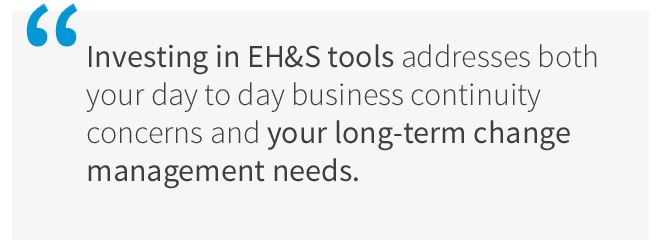
Changing market forces have allowed consumers to demand to know that the products they purchase are responsibly and ethically produced, and those consumers have the means to instantly communicate their joy or displeasure the minute your business fails to meet their standards.
So the real question is: can you afford to ignore this market trend toward sustainable change?
That’s why we consider a centralized EMS to be the ideal tool for helping manage change into the future. It helps your team complete the tasks, like compliance reporting, that they already do and gives you as an executive the standards and data to make informed decisions about how to manage change as you lead your business in adapting to the new goal posts of sustainability.
Here’s the bottom line: investing in EH&S tools like a standardized central EMS addresses both your day to day business continuity concerns and your long-term change management needs.
Proving Due Diligence during Times of Change
The other important consideration in change management is being able to prove that due diligence was done during all transition periods. Important audit trail data and other necessary environmental information is at particular risk for getting lost or overlooked during times of change, and it is often not until something goes wrong that that you’ll realize what you’re missing.
If something does go wrong, it’s vital that your business has all the data and documentation to prove that due diligence was performed to the best of your ability. That’s the best defense against excessive penalties and Notices of Violation (NOV).
Centralizing and standardizing your EH&S management through a singular system and universal database is also the best available tool for ensuring all the records needed to prove due diligence are at your fingertips. All your environmental, health and safety records are safely stored in your database, with clear information about who entered which data and when: in times of change or during audits post-transition this data can potentially protect your from losing tens of thousands of dollars.
Whether you are an Executive overseeing your business’s EH&S performance or an shop-floor EH&S professional, change management is a part of your portfolio. If you’re seeking sustainable business continuity, the first step is to unite all your separate streams of EH&S data into one system. Once you’ve standardized your EH&S data management, managing change will be a much simpler matter of ensuring quality work from your staff rather than having to reteach every new hire or transferred employee from scratch each time. A reliable stream of standardized EH&S data management translates into a reliable stream of completed compliance duties unhindered by slow-downs, confusion, and risk.
Supplemental Reading
This article mentioned some of the common risks and challenges with environmental management business management. If you want to learn more about risk management in general and learn some standardized methodologies you can start using today to measure the risks in your environmental department or processes, click the button below to download a short PDF guide on risk assessment methodologies.
Ask an ERA Expert:
Do you have any questions or concerns about the topic covered in this article? Want more insight? Now is your chance to ask one of ERA’s Environmental Specialists. Please leave your question or comment below and we’ll make sure one of our expert scientists responds.
This Blog Was Co-Authored By:


Tags:
Environmental Management
February 7, 2014
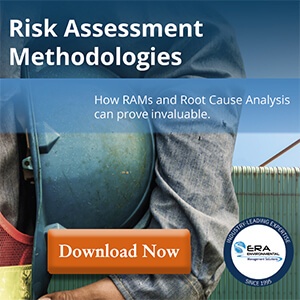
Comments